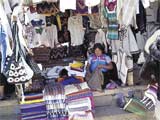Government discriminates against Indigenous people

An indigenous woman knits a shirt in her clothing shop. Knitting clothes is one of the few means of sustenance indigenous women in Chiapas have while the men work the land.
The armed insurgency in Chiapas in 1994 is brought by a group of Indigenous people. Indigenous people who are frustrated with what they see as a history of being excluded from progress, of discrimination against their heritage and of intolerance toward their cultural differences.
In Mexico, like in other mestizo nations, people of American Indian Ancestry (Natives) have been seen as inferior. During the Porfiriato, though, in Mexico, government institutionalized discrimination against the indigenous. As a consequence, today communities formed by indigenous people are the poorest in the nation and continue to suffer from a massive cultural reproach from the ethnocentric attitudes of European descendants.
Since the uprising in Chiapas more and more people, including people in government, are respecting the indigenous people of Mexico and their cultural traditions. What was before seen as antiquated is now seen as authentic and a source of pride. We are seeing indigenous traditions been brought to the forefront of cultural programs throughout the country.
Although the conflict in Chiapas is still ongoing, the conflict has already brought positive changes to Mexico. It has created a social conscious Indigenous traditions are worth rescuing and preserving. It has fostered a positive attitude toward multi-culturalism. More importantly, there is a vigorous discussion on the strengths of tolerance and the disadvantages of forced assimilation and ethnocentricity.
That said, the congress’ rejection of Los Acuerdos de San Andres is a clear indication Mexican legislation is running slow. It has been 12 years since Nicaragua acknowledged autonomous territories for the indigenous people of the Atlantic Coast.
The Colombian and Brazilian constitutions also recognize the autonomous territories of Indigenous people in their countries. In addition, together with Ecuador and Paraguay, Colombia and Brazil also acknowledge the collective rights of indigenous communities. Similarly, in 1999 Canada passed a law granting autonomous territories to the Inuit with no damage to Canada’s national unity.
The Mexican constitution accepts the country is multi-cultural, but unlike other Mestizo nations, it does not allow traditional normative institutions within indigenous communities. Further, until Mexico reforms its constitution to grant the necessary rights and protections to indigenous communities, these communities will continue to suffer from ethnocentric platforms aimed at forced assimilation. Unfortunately, it seems any Mexican government will only make the necessary amendments to the constitution pending the EZLN relinquishes its operations in the state of Chiapas and takes its cause into institutional democratic processes.
It is clear as much as the cause of the marginalized indigenous communities of Chiapas seems undemanding and vital, it did not receive the necessary attention before the armed insurgency of the EZLN.
Thus, the EZLN brought desperate attention to the forgotten indigenous people of Chiapas and Mexico. In spite of this, the EZLN, 10 years after the insurgency, has to reform its methods into more democratic ones if it is to succeed in bringing the much needed aid and cultural acceptance to the indigenous people of Mexico.
Your donation will support the student journalists of Missouri Southern State University. Your contribution will allow us to purchase equipment and cover our annual website hosting costs.



























